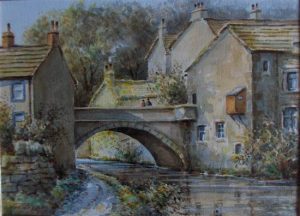
Jack Priestley’s Family History
This site is a work-in-progress. There is a massive amount to cover. I have included both male and female lines. Keep coming back for more.
I have numbered the generations working backwards from Jack’s as (1)
THOMAS BARKER and ANN SAGAR (7)
THOMAS BARKER was the son of an older Thomas Barker and Elizabeth Ceaton.
Baptism. Holy Trinity, Skipton.
1765 Jan 20 Thos son of Thos Barker Blacksmith and Elizath Wife Skipton. [1]
He was the third child in a family of seven, though two younger brothers, both called George, died in infancy.
Thomas took up his father’s profession of blacksmith, as did his grandfather, his older brother John and his younger brother Christopher.
ANN SAGAR. We know from the Skipton entry for her daughter’s baptism that Ann was the daughter of Warwick Sagar of Askrigg, Parish Clerk. Her grandfather also held this position.
Askrigg was a small market town in Upper Wensleydale, 24 miles north of Skipton.
 Askrigg [2]
Askrigg [2]
No baptism has been found for Ann among Warwick Sagar’s children, but on 2 Sep 1764 there is a baptism in Askrigg for his daughter Nanny. This is a diminutive for Ann.
Baptism. St Oswald, Askrigg.
1764 Sep 2 Nanny Dau of Warwick Sagar of Askrigg
This would make her a few months older than Thomas.
Her mother was Ann Fawcet.
She was the third of eight children, one of whom died in infancy. Her mother died when Ann was eighteen Her father later remarried and three more children.
There must be a story behind Ann’s move 24 miles from Askrigg to Skipton, where she was resident at the time of her marriage in 1786.
It is possible that she moved to Skipton with her uncle Edmund Sagar, a noted clockmaker. He moved from Askrigg to Middleham and then to Skipton. The second move took place between 1778 and 1793
 2-10Newmarket St, Skipton
2-10Newmarket St, Skipton
Edmund Sagar, clockmaker, had premises at No.8, the fourth upper window from the left. [3]
The couple married at Holy Trinity, Skipton, in 1786
Banns. Holy Trinity, Skipton. 1786 Jul 3.
The ink is faded, but we can read: Thos Barker of this parish Blacksmith and … Ann Sagar of this parish Spinster. Thomas signs his name, while Ann makes her mark. Her father must have been literate, but he evidently did not teach his daughter to read and write.
The witnesses were William ? and John Cooke.
The couple had eight children.
Baptisms. Holy Trinity, Skipton.
1787 Elizabeth Barker Dr of Thomas Barker of Skipton Blacksmith Son of Thos: Barker of Do Blacksmith and Ann Dr of Warwick Sagar of Askrig Parish Clerk. Born Oct 27 bapt Nov 25.
1789 born Apr 25, bapt July 26 Thomas
1792 born Feb 18, bapt Mar 11 John
1794 born Jul 22, bapt Sep 7 Ann
Ann died the following year. She died 3 Mar 1795was buried two days later. The cause of death is not given.
1797 born Mar 15, bapt Apr 16 James.
1799 born Dec 2, bapt 1800 May 9 ?Susy
1802 born Dec 10, bapt 1803 Jan 23 George
1805 born Oct 13, bapt Dec 8 Charles
The family lived through the troubled years of the French Revolutionary and Napoleonic Wars, which ended with the Battle of Waterloo in 1815. The interruption to shipping had an adverse effect on trade.
Their eldest daughter Elizabeth married the cotton spinner Edward Harrison in 1812.
Baines’s Directory and Gazetteer Directory of 1822 has Thomas Barker, Blacksmith, living in Bridge St.
In Pigot’s Directory of 1829 he is at Mill bridge, which may be the same smithy.
 Mill Bridge, Skipton [4]
Mill Bridge, Skipton [4]
Thomas died in 1832, the year of the Great Reform Act. He was buried on Jun 1, aged 67.
The 1832 Reform Act widened the franchise. Among other measures, it gave the vote to all householders in boroughs who paid a yearly rental of £10 or more.
Ann lived six more years. She was buried on 27 Feb 1838, aged 75.
In the 1841 census for Skipton, their eldest son Thomas is living in Chancery Lane with his family. He is a whitesmith, as is his son John.
A whitesmith works in lighter metals, typically tin, but may finish other metalwork, including iron goods. They were important in early textile engineering, to help combat the rust from the damp conditions necessary in the mills to prevent the yarn from breaking.
[1] BMDs from Yorkshire Registers on Findmypast
[2] http://www.picturesofengland.com/img/X/1176349.jpg
[3] http://www.cravenherald.co.uk/resources/images/1564154.jpg?display=1&htype=100000&type=responsive-gallery
[4] http://www.notjusthockney.info/wp-content/uploads/2015/07/PARKER-William-E-Ask-Art-the-mill-bridge-skipton.jpg
NEXT GENERATION: 6. HARRISON-BARKER
PREVIOUS GENERATIONS: 8. BARKER-CEATON
